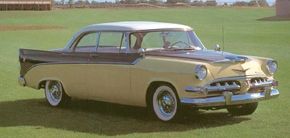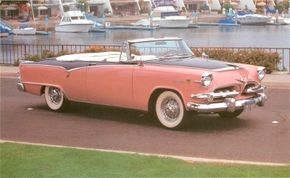Having made its performance point for 1953-1954, Dodge emphasized styling for the 1955-1956 Dodge D-500. Not that it stood pat on performance -- no make could afford to, what with the horsepower race tighter than ever -- so the 1955s became not only the most potent Dodges ever, but among the fastest cars in all Detroit.
Advertisement
If not totally new, they were unquestionably different from any Dodges than had gone before -- part of the sudden, dramatic swing to high power and high style evident throughout the 1955 Chrysler Corporation line. This meant bolder, brighter cars -- such as the Dodge D-500 -- with bigger engines and mostly longer wheelbases -- in Dodge's case a new 120-inch span across the board, up 1.5 inches from 1953-1954.
Offerings were blissfully simplified into Coronet sixes and V-8s, and V-8-only Royal and new Custom Royal models. Hardtop coupes were subtitled Lancer along with the Custom Royal convertible, which topped the line at $2,748.
Though Virgil Exner oversaw the styling of Chrysler Corporation's 1955s, Dodge and Plymouth received the attention of his assistant, Maury Baldwin. All the firm's cars embodied the "Forward Look," Dodge calling its version "Flair-Fashion." Announcing the Dodge D-500 was an aggressive snout with two large horizontal bars wrapped around from the sides into a divided grille cavity.
A dummy scoop appeared at the front of the hood and flared outward and back toward the cowl. On some models this ran to the rear fenders as an upper body molding, dipped near the C-pillars; in a contrasting color, the area thus defined made what was still a rather high-sided body look lower. Cars conventionally two-toned at the beltline looked a lot chunkier.
Other features included "New Horizon" wraparound windshield and, for Custom Royal Lancers, embryonic chrome tailfins. Wild three-tone paint jobs could be had on Custom Royals, with different colors on roof, body sides, and the hood/deck area.
Dodge's famed "Red Ram" V-8 expanded to 270 cubic inches for 1955 -- but wasn't necessarily a true hemi. It was if you bought a Custom Royal, where you got a Super Red Ram with an ample 183 horsepower.
Otherwise you got what Chrysler termed a "polyspherical" engine. Its key difference was intake and exhaust valves placed diagonally across from one another rather than directly opposite, which permitted a single rocker shaft for each cylinder bank instead of two and improved plug accessibility. With lighter rocker arms and this simpler valvetrain, the poly weighed less and cost less to make than the hemi, yet retained most of its desirable breathing qualities. Most of its power, too: 175 bhp.
For more on how the new Dodge vision manifested in the 1955-1956 Dodge D-500, go to the next page.
For more information on cars, see:
- Classic Cars
- Muscle Cars
- Sports Cars
- Consumer Guide New Car Search
- Consumer Guide Used Car Search
Advertisement


